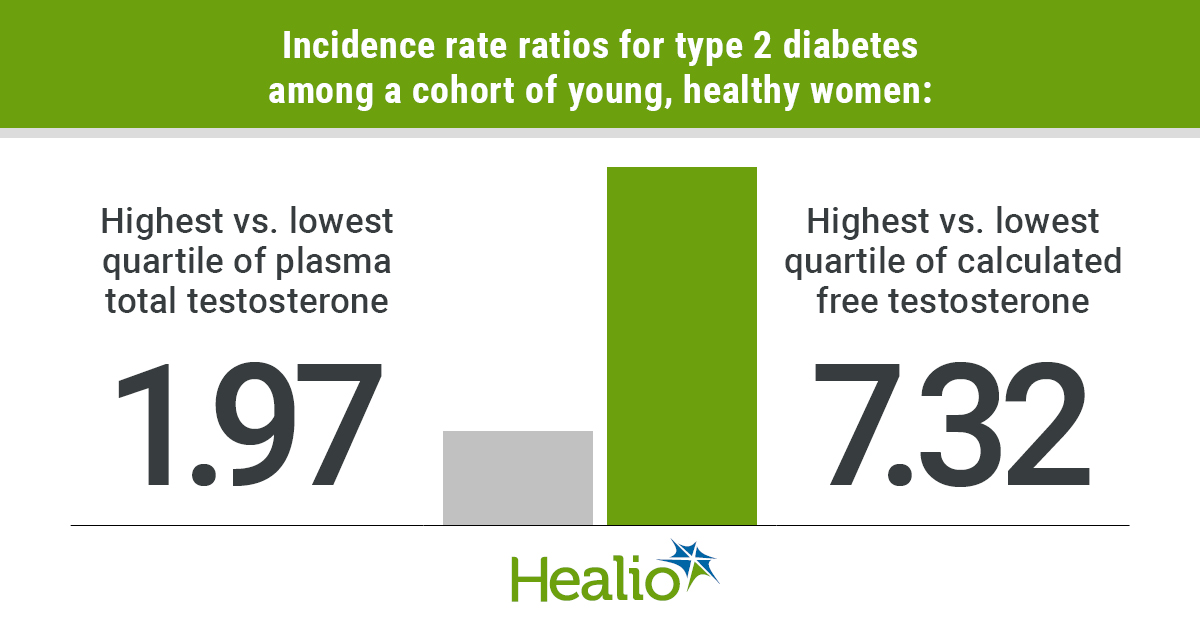High endogenous testosterone levels contribute to type 2 diabetes risk among young, healthy women

High plasma levels of endogenous total and circulating free testosterone are associated with a two- to sevenfold increased risk for developing type 2 diabetes among young, healthy women without comorbidities, according to findings from a large retrospective study published in the Journal of the Endocrine Society.
“The findings of this study suggest high plasma levels of testosterone could play a role in the pathogenesis of type 2 diabetes among women,” Jon Jarløv Rasmussen, MD, PhD, a specialist registrar and postdoctoral researcher in the department of endocrinology at Rigshospitalet in Copenhagen, Denmark, told Healio. “The incidence of type 2 diabetes was rather low in the study, but the results implicate that screening for type 2 diabetes among women with higher plasma levels of testosterone may be beneficial, even among women who are young and without established comorbidities, such as polycystic ovary syndrome.”
In a retrospective study, Rasmussen and colleagues analyzed data from 8,876 healthy women (mean age, 38.5 years) who provided blood samples to measure plasma testosterone, dehydroepiandrosterone-sulfate (DHEAS), dihydrotestosterone (DHT) and sex hormone-binding globulin (SHBG) between January 2007 and December 2015. Researchers analyzed androgens using tandem liquid-chromatography mass spectrometry. Researchers used Poisson regression models to calculate incidence rate ratios for developing type 2 diabetes during a median follow-up of 8.1 years, stratified by androgen quartiles.
During 69,728 person-years, 69 women received a type 2 diabetes diagnosis.

Researchers found that women in the highest quartiles for plasma total testosterone and calculated free testosterone were more likely to develop type 2 diabetes during follow-up vs. women in the lowest quartile, with IRRs of 1.97 (95% CI, 1.01-3.85) and 7.32 (95% CI, 2.84-18.83), respectively. Levels of SHBG were inversely associated with type 2 diabetes, whereas DHEAS and DHT were not associated with incident type 2 diabetes. Results persisted after adjustment for age, plasma SHGB and socioeconomic factors.
The researchers noted that there was limited information on the body composition and BMI of the women analyzed for the study.
“Interestingly, a recent study demonstrated that endogenous androgens are inversely related to BMI in healthy women,” the researchers wrote. “In line with this, we noted plasma SHBG was lowest among women in quartile 1 and highest among women in quartile 4 of plasma total testosterone. Thus, suggesting that women in the lowest quartile of plasma total testosterone could feature highest insulin resistance and BMI at baseline, while women in the highest quartile of plasma total testosterone potentially feature lowest insulin resistance and BMI. Accordingly, we may have underestimated, rather than overestimated, the influence of testosterone on the risk of developing type 2 diabetes in women.” – by Regina Schaffer
For more information:
Jon Jarløv Rasmussen, MD, PhD, can be reached at the Department of Endocrinology, University Hospital of Copenhagen, Rigshospitalet, Ole Maaløes Vej 24, opg. 7562, DK-2200, Denmark; email: jon.ras@dadlnet.dk; Twitter: @JonRasmussen9.
Disclosures: The authors report no relevant financial disclosures.

